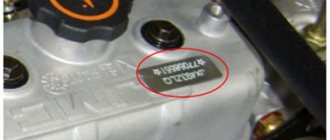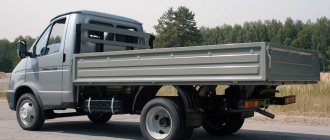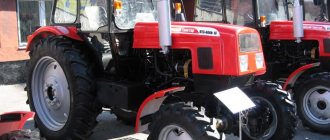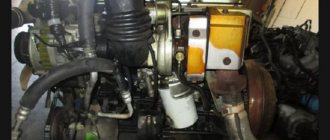Detailed description, device
The body is all-metal on a steel frame with steel sheet covering. In recent years, it has been additionally treated with an anti-corrosion compound . The interior equipment could be utilitarian with leatherette seats or trimmed with velor and artificial leather. The suspension of all wheels is spring . The braking system is pneumohydraulic.
In 1989, the bus was equipped with a domestic ZMZ-513 - a simple V-shaped carburetor-type device with 8 valves, which are located at right angles. The maximum power threshold stops at 125 hp. With. The speed limit is 90 km/h. Over the years of operation, the engine has proven itself to be reliable under all conditions.
Bus KAvZ-3976. Photo Wikipedia
The KAVZ-3976 model received a new power unit in 2005 . It was a diesel unit MMZ D-245.7. Its technical characteristics have been slightly improved. First of all, the manufacturer worked on the aspect of environmental standards; now the engine complies with European standards EURO-2 . As for technical nuances, the power indicator decreased by almost 3 units. (122.4 hp), high-speed, on the contrary, increased by 5 units, in the new modification the bus could accelerate to 95 km/h .
The chassis was borrowed from the GAZ-33074 , and not only that. It can be called the progenitor of the KAvZ-3976, since the bus was equipped with the same mechanical transmission, designed for 5 speeds, an engine and other equipment elements. It is worth paying attention to the electrics. It’s problematic to find something new here; everything was also inherited from the GAZ-33074. But with one exception: the new bus had interior lighting, which had not been used before.
Main modifications:
- KAVZ 397653 is a modification of the basic model, designed for transporting schoolchildren to their places of study. It was equipped with a slightly modified ZMZ-513.10 engine with a maximum power of 90 horsepower. The rotation speed increased to 3400 rpm. The engine meets the requirements of EURO-1 . The bus received a platform extended to 8.47 meters and a second door for boarding passengers. Special equipment did not allow the vehicle to accelerate to a speed greater than 60 km/h, which was done for the safety of children. Each seat received its own seat belt and a quick communication button with the driver. The number of seats has increased to 22 units. All traumatic protrusions were removed from the design, and the remaining elements were equipped with soft pads. Fuel consumption of KAVZ 397653 is 23 liters per 100 kilometers. The bus is painted yellow and has the words “school bus” on the sides. The model had an improved braking system, and also added ABS to help the driver in emergency situations. The wheel formula of the vehicle is 4x2.
- KAVZ 3976-011 is a gas-cylinder modification of the base model. It is equipped with an Italian system for operating on liquefied gas and two refill cylinders of 90 liters each.
- KAVZ 3976-020 is a modification for the northern regions of the country. The model received an insulated interior, a powerful heater and an engine pre-heater to start the power unit in any frost.
Bus KAvZ-3976, school. Photo Wikipedia
Additional modifications:
- KAvZ-3976 - basic with a ZMZ-511.10 gasoline engine. Produced in 1989-2000.
- KAvZ-3976-0000011 – on liquefied gas. Produced since 1991.
- KAVZ-3976-0000012 - mountain, featured an electrodynamic retarder, a recoil device, seat belts on all seats, an additional fuel tank in the rear overhang, and four shock absorbers in the rear suspension.
- KAvZ-3976-0000013 – increased comfort.
- KAvZ-3976-0000014 – cargo-passenger, produced since 1994.
- KAvZ-3976-0000015 – simplified for rural areas.
- KAvZ-3976-0000016 – increased comfort, distinguished by seats with headrests.
- KAvZ-3976-0000018 – southern.
- KAvZ-3976-0000021 – increased comfort, interior for 16 seats.
- KAvZ-397601 - northern, featured double glazing, additional dependent and two independent interior heaters, an additional fuel tank in the rear overhang, the driver's seat was separated by a partition.
- KAvZ-397601-0000014 – northern cargo-passenger.
- KAvZ-39762 - modernized, featured a ZMZ-513.10 engine with a power of 125 hp, produced in 2000-2008.
- KAvZ-39762-0000023 – school, produced in 2001-2007.
- KAvZ-397621 – northern.
- KAvZ-397622 – ritual.
- KAvZ-39763 - with a GAZ-5441 turbodiesel, produced in 1996-1998.
- KAvZ-39763 - with diesel engine D-245.7E2 (Euro-2), produced in 2005-2008.
- KAvZ-39765 – extended. Wheelbase 4550 mm, interior with 22 seats, suspension with anti-roll bar, produced since 1994.
- KAvZ-39765-0000021 – extended and increased comfort.
- KAvZ-39765-0000022
- KAvZ-39765-0000023 – school extended, produced in 2001-2008.
- KAvZ-39765-0000027
- KAvZ-39766 - all-wheel drive (all-terrain vehicle) on the GAZ-3308 chassis, produced in 2004-2007.
- KAvZ-39767 – with MMZ D-245.7 diesel engine.
- KAvZ-39767-0000023 – school.
- KAvZ-39768 - with a Japanese diesel engine Hino W04CT (experimental), developed in 1993.
- KAvZ-39769 - extended (experimental), the interior is designed for 32 seats.
Bus technical characteristics
The technical characteristics of the KAVZ 3976 cannot be called outstanding. To reduce the cost of mass production, the development of the bus did not use the most advanced technologies available at that time. But this did not prevent him from successfully coping with the responsibilities assigned to him. The first KAVZ 3976 models were equipped with a ZMZ-513 engine with a maximum net power of 125 horsepower. It was a simple and reliable carburetor eight-cylinder engine with a V-shaped arrangement of cylinders at right angles.
The working volume of the power unit was 4.25 cubic centimeters, and the maximum torque was 294 N*m. With such an engine, the bus reached speeds of up to 90 km/h. Since 2005, model 3976 has been equipped with a new MMZ D-245.7 power unit with a capacity of 122.4 horsepower. This is a four-cylinder in-line diesel engine with a displacement of 4.75 liters. The rotation speed is 2400 rpm and the torque is 422 N*m. The engine complies with international environmental standards EURO-2. The new power unit allows the bus to accelerate to 95 km/h.
The base model for the KAVZ 3976 was the GAZ 33074 chassis. From its “parent” the bus received a mechanical five-speed gearbox, an engine and many other components and assemblies. The electrical circuit of the KAVZ 3976 is completely identical to the GAZ one, only it has added interior lighting. Dimensional parameters of the bus: length - 6.915 meters, width - 2.38 meters, height - 2.38 meters, front track - 1.63 meters, rear track - 1.69 meters, wheelbase - 3.77 meters. Number of seats - 20 (+ driver's seat).
Total capacity - 28 passengers. For boarding, there was a single front door that opened and closed manually. This was not the most successful design decision, since the driver very often had to close the door himself, for which a special belt was designed. The closing mechanism often broke and the door stopped closing tightly. This led to constant flapping when driving and a draft in the cabin. The all-metal body of the carriage layout received anti-corrosion treatment before assembly. The product lifespan was about 6 years.
And now - Gorbaty: test drive KAVZ-4270 CNG
Many people can still distinguish the old “Kavzik” from other buses only by the hood layout. A bus with a “face” from a GAZ-53 (or at least 3307 or 3309) is a KAvZ. But the times of the “big-faced caucasians” are long gone... They are no more, my beloved ones! But wipe your tears, men: the Kurgan plant is more alive than all living things and even produces buses. Moreover: these buses are far from the worst, they have a cool automatic transmission control panel with buttons, cameras in the front cabin and a gas engine somewhere in the back.
Advantages
It was assumed that the bus would be used in rural areas where there are many unpaved surfaces. Because of this reason, additional details were initially included in the designed model for a high level of cross-country ability. As for the chassis, it was made with an excessive margin of safety.
For its time, the KAVZ 685 bus was an advanced vehicle that had good technical characteristics and was on par with the best examples:
- Four-stroke carburetor power plant (3M3-53A).
- V-shaped layout
- Eight-cylinder engine capable of developing 122 hp.
- RPM 3220.
- Engine capacity is 4255 cubic centimeters.
Fuel consumption is approximately 24 liters per 100 kilometers. Moreover, the car could move at speeds of up to 90 kilometers per hour. The gearbox was a four-speed manual. The tank held about 110 liters of fuel. Essentially, the bus was an improved GAZ model with serial number 53-12. This model had synchronizers for 3rd and 4th gear.
The clutch had a single disc and was engaged using a hydraulic drive. The brake system had two circuits. There were also drum elements that connected both wheels.
There was also a hydraulic drive, which included an effective vacuum booster. The most versatile tires were installed, tread 8.20 R20.
Capacity: number of seats 21 total number of seats 28 number of service seats 1Curb weight 4030 kg. Including: front axle 1530 kg. on the rear axle 2500 kg.
Gross weight 6289 kg. Including: front axle 1680 kg. on the rear axle 4609 kg.
| Max. speed 90 km/h. Acceleration time to 60 km/h 33.6 s. Max. climbability 26% Run-out from 50 km/h 746 m. Braking distance from 60 km/h 26.4 m. Control fuel consumption at 60 km/h, l/100 km 18.3 l. Turning radius: on the outer wheel 8.0 m. overall 9.0 m. |
Engine.
Maud. ZMZ-53-11, petrol, V-shape. (900), 8-cyl., 92×80 mm, 4.25 l, compression ratio 7.6, operating order 1-5-4-2-6-3-7-8; power 88.3 kW (120 hp) at 3200 rpm; torque 284.5 Nm (29 kgf-m) at 2000-2500 rpm; carburetor K-135; air filter - inertial oil filter.
Transmission.
The clutch is single-plate with peripheral springs, the release drive is hydraulic. Gearbox - mod. GAZ-53-12, 4-speed, gear. numbers: I-6.55; II-3.09; III-1.71; IV-1.00; ZH-7.77; synchronizers - in 3rd and 4th gears. The cardan transmission consists of two shafts with an intermediate support. Main gear - single, hypoid, gear. number 6.17.
Wheels and tires.
Wheels - disc, rims 6, OB-20 with side rings, fastening with 6 studs. Tires 8.25-20 (240-508) mod. IK-6AM, NS-10, or 8.25R20 (240R508) mod. K-55, KI-63, K-84, tread pattern - universal, tire pressure of front wheels 2.8, rear - 4.3 kgf/cm. sq. , number of wheels 6+1.
Suspension.
Dependent, front - on semi-elliptical springs with shock absorbers, rear - on semi-elliptical springs with additional springs, four shock absorbers.
Brakes.
The service brake system is dual-circuit, with a hydraulic drive and a vacuum booster, drum mechanisms (diameter 380 mm, front lining width 80, rear linings 100 mm), cam release. Parking brake - transmission, drum, drive - mechanical. Spare brake - any of the circuits of the service brake system.
Steering.
The steering mechanism is a globoidal worm with a three-ridge roller, gear ratio 21.3. Steering wheel play up to 100.
Electrical equipment.
Voltage 12 V, ac. battery 6ST-75EMS, generator 162.3701 with built-in rectifier, voltage regulator 13.3702, starter ST230-A, distributor 24.3706, ignition coil B11 6, spark plugs A11-3.
Filling volumes and recommended operating materials.
Fuel tank - 105 l, gasoline A-76; cooling system - 28l, water or coolant; engine lubrication system - 8.0 l, all-season M-8B1 or M-8B1; steering gear housing - 0.6 l, TSp-15K; rear axle housing - 8.2 l, TSp-14GIP; hydraulic brake and clutch drive - 1.0 l, AZh-12T; shock absorbers - 6×0.4, spindle oil AU; windshield washer reservoir - 2.0 l, NIISS-4 liquid mixed with water.
Weight of units
(in kg). Engine with equipment and clutch - 256, gearbox - 57, driveshaft - 25, front axle - 138, rear axle - 268, body - 1600, wheel and tire - 84, radiator - 16.
General characteristics
Below are standard transport sizes:
- Length - 6.59 meters;
- Width – 2.49 meters;
- Height – 3 meters;
- The clearance between the road surface and the axle is 1.6 meters;
- Bus weight 4 tons;
- Loaded 6.45 tons;
- Load spread: front axle 2.3 tons, rear axle 4.3 tons;
- Turning radius 8.9 meters.
The KAVZ 685 bus can accommodate 28 passengers. Moreover, one door was intended for boarding and disembarking. At the stern there was also a door and an exit in case of an emergency. The well-heated cabin received numerous good reviews from passengers.
By the way, ventilation was regulated by opening and closing windows. It was quite convenient.
The car body is all-metal. The presence of a hood made repair work easier for the driver. If necessary, the engine could be repaired without any problems. The bus chassis was installed from the “lawn” 53A. It was quite suitable for driving over rough terrain.
The presence of a large number of standard spare parts on the market eliminated repair issues. The engine of the car could be put in order even in the field.
Driver's seat
As for the driver's seat, it was well equipped. The seat could be fixed in different positions. There was no hydraulic control boost. However, this was more than compensated for by the presence of large wheels, which made driving the vehicle easier.
All control devices are located compactly in one place. They are simple and understandable even for a beginner. The rear view mirrors are large and provide good visibility. The windshield is divided by a bulkhead. And most importantly, there is a separate snowblower on each half.
Modifications
Over twenty years, a large number of different modifications have been released.
KAvZ 685S - this model is adapted for work in northern latitudes. Moreover, the machine can be used even at -60 degrees. The interior of the car is lined with insulation from the inside, additional double-glazed windows and backup heating devices have been installed.
KavZ 685G is a mountain version of the model. On the car you can find more powerful brakes equipped with an electrodynamic element. Seat belts are attached to each seat
KAvZ 685M is a modernized model, it has an improved power plant.
ZMZ-53-11 (16 hp), maximum speed up to 85 kilometers per hour.
KAvZ 3270 is a more modern version of the famous bus. The car was produced in compliance with new requirements and environmental standards.
KAVZ 685M and other models cost from 180,000 to 529,000 rubles. Although there are variations that cost more than one million. The condition of such mechanisms is very good. They can serve faithfully for a long time.
KAvZ-3976 Wikipedia
| KAvZ-3976 | |
| Manufacturing plant | KAvZ (Kurgan, USSR) KAvZ (Kurgan, Russia) |
| Produced, years | 1989—2008 |
| Gross weight, t | 4,45 |
| Curb weight, t | 4,45 |
| Max. speed, km/h | 90 |
| Bus class | small |
| ECO standard | Euro 2 |
| Seating | 20+1 |
| Full capacity (8 people/m²) | 28 |
| Front wheel track, mm | 1 630 |
| Rear wheel track, mm | 1 690 |
| Length, mm | 6 915 |
| Width, mm | 2 380 |
| Roof height, mm | 2 380 |
| Base, mm | 3 770 |
| Number of doors for passengers | 1 |
| Door formula | 1 (+1 for driver) |
| Engine model | ZMZ - 513.10 |
| Number of cylinders | 8 |
| Cylinder arrangement | V-shape at 90 degree angle |
| Power, l. With. | 125 |
| Torque, Nm | 294 |
| Volume, cm³ | 4,25 |
| Fuel consumption at 60 km/h, l/100 km | 22,8 |
| Gearbox model | GAZ-3307 |
| Gearbox type | mechanical |
| Number of gears | 5-speed |
| Media files on Wikimedia Commons | |
KAvZ-3976
- Soviet and Russian middle-class bus with a bonnet design on GAZ-3307 and GAZ-3309 truck chassis.
History[ | ]
In 1989, the basic 20-seater KAVZ-397620 bus was launched on the GAZ-33074 bus chassis with a ZMZ-513 V8 carburetor engine with a power of 120 hp. later 125 hp The second digit of the base model index according to GOST has changed from 2 (bus class) to 9 (special vehicle class) to simplify the certification of special versions. Subsequently, based on model 397620, a number of cargo-passenger and special (sanitary, ritual, operational-service, etc.) modifications were produced. Since 1993, the KavZ-39765 middle-class bus with 28 seats was produced on a chassis lengthened from 3.7 m to 4.55 m. There was also a longer 32-seater (34 seats in the school version) version of the KAvZ-39769 with a 5.4-meter wheelbase, but it did not go into production due to insufficient torsional rigidity of the chassis. In 1995-1997 modification 39763 was produced on the GAZ-3309 chassis with a turbodiesel 4-cylinder air-cooled engine GAZ-5441 (116 hp). Since 2001, in accordance with GOST R51160 “Buses for transporting children”, based on model 39765, the KavZ-397653 school bus has been produced in fairly large quantities. On the all-wheel drive chassis GAZ-3308 "Sadko" in 2004-2005. A batch of KAvZ-39766 rotation buses was manufactured. Since 2001, the extended diesel version 39767 with the MMZ D-245.7 engine went into production; since 2005, the diesel modification KAvZ-397630 of the base model with the MMZ D-245.7E2 engine (Euro 2) was resumed.
On January 18, 2008, production of KAvZ-3976 was discontinued. A total of 450 thousand were released [ source not specified 328 days
] buses of this model.









